本文分享自华为云社区《在小熊派Micro上用OpenHarmory3.0点亮LED(1)LED驱动开发》,作者:神龙居市。
项目总览
作为一个代表性的完整的开发,本案例可以分成3大部分:代码文件的规划,LED灯的驱动开发,点亮LED的业务开发。
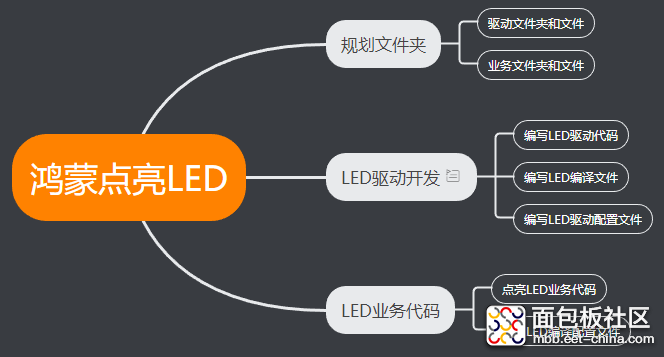
一、LED驱动开发
1.1.确定目录结构
1.1.1.根据HDF框架以组件化的驱动模型作为核心设计思路,HDF框架将一类设备驱动放在同一个host里面,开发者也可以将驱动功能分层独立开发和部署,支持一个驱动多个node,HDF驱动模型如下图
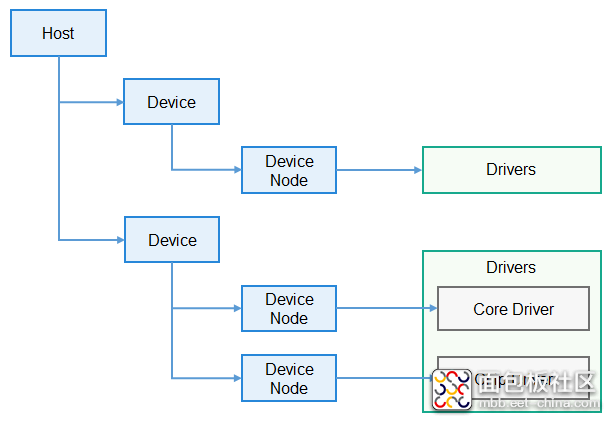
1.1.2.本案例目录
在./device/st/drivers路径下新建一个led的目录,用来存放驱动源码文件。
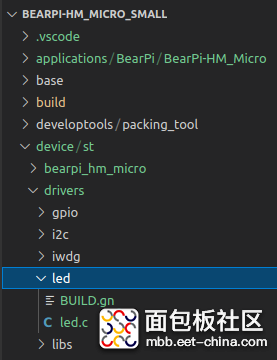
在./device/st/bearpi_hm_micro/liteos_a/hdf_config路径下新建led文件夹,并创建驱动配置文件led_config.hcs
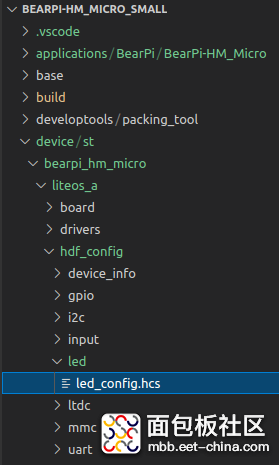
1.2.LED驱动实现
1.2.1.驱动实现包含驱动业务代码和驱动入口注册,在led.c文件中添加以下代码
#include "hdf_device_desc.h" #include "hdf_log.h" #include "device_resource_if.h" #include "osal_io.h" #include "osal.h" #include "osal_mem.h" #include "gpio_if.h" #define HDF_LOG_TAG led_driver // 打印日志所包含的标签,如果不定义则用默认定义的HDF_TAG标签 #define LED_WRITE_READ 1 // 读写操作码1 enum LedOps { LED_OFF, LED_ON, LED_TOGGLE, }; struct Stm32Mp1ILed { uint32_t gpioNum; }; static struct Stm32Mp1ILed g_Stm32Mp1ILed; uint8_t status = 0; // Dispatch是用来处理用户态发下来的消息 int32_t LedDriverDispatch(struct HdfDeviceIoClient *client, int cmdCode, struct HdfSBuf *data, struct HdfSBuf *reply) { uint8_t contrl; HDF_LOGE("Led driver dispatch"); if (client == NULL || client->device == NULL) { HDF_LOGE("Led driver device is NULL"); return HDF_ERR_INVALID_OBJECT; } switch (cmdCode) { /* 接收到用户态发来的LED_WRITE_READ命令 */ case LED_WRITE_READ: /* 读取data里的数据,赋值给contrl */ HdfSbufReadUint8(data,&contrl); switch (contrl) { /* 开灯 */ case LED_ON: GpioWrite(g_Stm32Mp1ILed.gpioNum, GPIO_VAL_LOW); status = 1; break; /* 关灯 */ case LED_OFF: GpioWrite(g_Stm32Mp1ILed.gpioNum, GPIO_VAL_HIGH); status = 0; break; /* 状态翻转 */ case LED_TOGGLE: if(status == 0) { GpioWrite(g_Stm32Mp1ILed.gpioNum, GPIO_VAL_LOW); status = 1; } else { GpioWrite(g_Stm32Mp1ILed.gpioNum, GPIO_VAL_HIGH); status = 0; } break; default: break; } /* 把LED的状态值写入reply, 可被带至用户程序 */ if (!HdfSbufWriteInt32(reply, status)) { HDF_LOGE("replay is fail"); return HDF_FAILURE; } break; default: break; } return HDF_SUCCESS; } // 读取驱动私有配置 static int32_t Stm32LedReadDrs(struct Stm32Mp1ILed *led, const struct DeviceResourceNode *node) { int32_t ret; struct DeviceResourceIface *drsOps = NULL; drsOps = DeviceResourceGetIfaceInstance(HDF_CONFIG_SOURCE); if (drsOps == NULL || drsOps->GetUint32 == NULL) { HDF_LOGE("%s: invalid drs ops!", __func__); return HDF_FAILURE; } /* 读取led.hcs里面led_gpio_num的值 */ ret = drsOps->GetUint32(node, "led_gpio_num", &led->gpioNum, 0); if (ret != HDF_SUCCESS) { HDF_LOGE("%s: read led gpio num fail!", __func__); return ret; } return HDF_SUCCESS; } //驱动对外提供的服务能力,将相关的服务接口绑定到HDF框架 int32_t HdfLedDriverBind(struct HdfDeviceObject *deviceObject) { if (deviceObject == NULL) { HDF_LOGE("Led driver bind failed!"); return HDF_ERR_INVALID_OBJECT; } static struct IDeviceIoService ledDriver = { .Dispatch = LedDriverDispatch, }; deviceObject->service = (struct IDeviceIoService *)(&ledDriver); HDF_LOGD("Led driver bind success"); return HDF_SUCCESS; } // 驱动自身业务初始的接口 int32_t HdfLedDriverInit(struct HdfDeviceObject *device) { struct Stm32Mp1ILed *led = &g_Stm32Mp1ILed; int32_t ret; if (device == NULL || device->property == NULL) { HDF_LOGE("%s: device or property NULL!", __func__); return HDF_ERR_INVALID_OBJECT; } /* 读取hcs私有属性值 */ ret = Stm32LedReadDrs(led, device->property); if (ret != HDF_SUCCESS) { HDF_LOGE("%s: get led device resource fail:%d", __func__, ret); return ret; } /* 将GPIO管脚配置为输出 */ ret = GpioSetDir(led->gpioNum, GPIO_DIR_OUT); if (ret != 0) { HDF_LOGE("GpioSerDir: failed, ret %d\n", ret); return ret; } HDF_LOGD("Led driver Init success"); return HDF_SUCCESS; } // 驱动资源释放的接口 void HdfLedDriverRelease(struct HdfDeviceObject *deviceObject) { if (deviceObject == NULL) { HDF_LOGE("Led driver release failed!"); return; } HDF_LOGD("Led driver release success"); return; } // 定义驱动入口的对象,必须为HdfDriverEntry(在hdf_device_desc.h中定义)类型的全局变量 struct HdfDriverEntry g_ledDriverEntry = { .moduleVersion = 1, .moduleName = "HDF_LED", .Bind = HdfLedDriverBind, .Init = HdfLedDriverInit, .Release = HdfLedDriverRelease, }; // 调用HDF_INIT将驱动入口注册到HDF框架中 HDF_INIT(g_ledDriverEntry);
复制代码1.2.2.编译脚本文件
在led/BUILD.gn文件中添加以下代码,将led.c编译成hdf_led
import("//drivers/adapter/khdf/liteos/hdf.gni")hdf_driver("hdf_led") { sources = [ "led.c", ] }
复制代码在/device/st/drivers/BUILD.gn文件中添加以下代码,将hdf_led编译进内核,"led"是新增内容
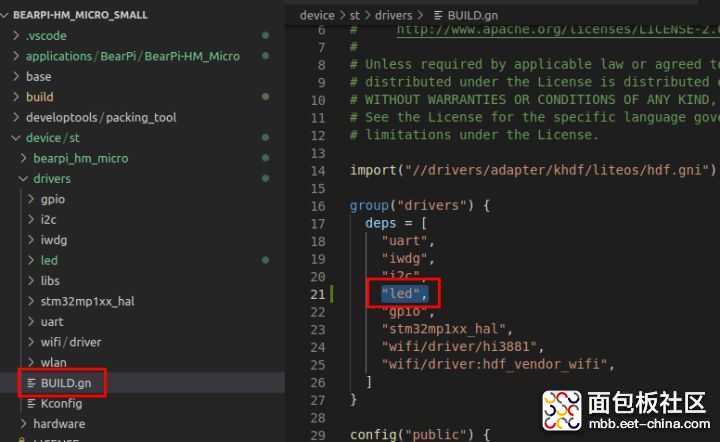
1.3.驱动配置
HDF使用HCS作为配置描述源码,驱动配置包含两部分,HDF框架定义的驱动设备描述和驱动的私有配置信息。
HDF框架加载驱动所需要的信息来源于HDF框架定义的驱动设备描述,因此基于HDF框架开发的驱动必须要在HDF框架定义的device_info.hcs配置文件中添加对应的设备描述,所以我们需要在device\st\bearpi_hm_micro\liteos_a\hdf_config\device_info\device_info.hcs中添加LED设备描述
device_led :: device { // led设备节点 device0 :: deviceNode { // led驱动的DeviceNode节点 policy = 2; // policy字段是驱动服务发布的策略,在驱动服务管理章节有详细介绍 priority = 10; // 驱动启动优先级(0-200),值越大优先级越低,建议默认配100,优先级相同则不保证device的加载顺序 preload = 1; // 驱动按需加载字段 permission = 0777; // 驱动创建设备节点权限 moduleName = "HDF_LED"; // 驱动名称,该字段的值必须和驱动入口结构的moduleName值一致 serviceName = "hdf_led"; // 驱动对外发布服务的名称,必须唯一 deviceMatchAttr = "st_stm32mp157_led"; // 驱动私有数据匹配的关键字,必须和驱动私有数据配置表中的match_attr值相等 } }
复制代码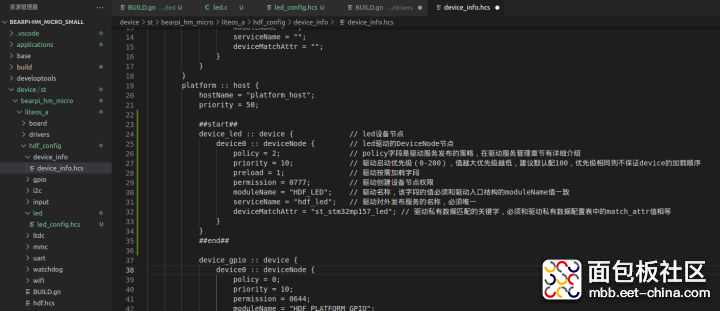
1.4.私有驱动信息配置
如果驱动有私有配置,则可以添加一个驱动的配置文件,用来填写一些驱动的默认配置信息,HDF框架在加载驱动的时候,会将对应的配置信息获取并保存在HdfDeviceObject 中的property里面,通过Bind和Init传递给驱动,所以我们需要在device\st\bearpi_hm_micro\liteos_a\hdf_config\led\led_config.hcs中添加LED私有配置描述。
root { LedDriverConfig { led_gpio_num = 13; match_attr = "st_stm32mp157_led"; //该字段的值必须和device_info.hcs中的deviceMatchAttr值一致 } }
复制代码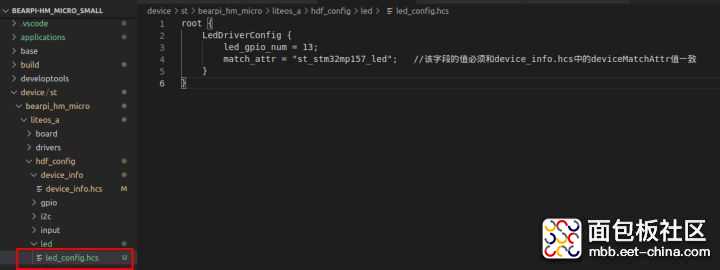
1.5.板级配置入口文件
配置信息定义之后,需要将该配置文件添加到板级配置入口文件device\st\bearpi_hm_micro\liteos_a\hdf_config\hdf.hcs
#include "device_info/device_info.hcs"#include "led/led_config.hcs"
复制代码二、点亮LED业务代码
2.1.创建目录
编写业务时,务必先在./applications/BearPi/BearPi-HM_Micro/samples路径下新建一个目录(或一套目录结构),用于存放业务源码文件.
在samples文件夹下增加my_led_app文件夹,并新建BUILD.gn和my_led_app.c两个文件
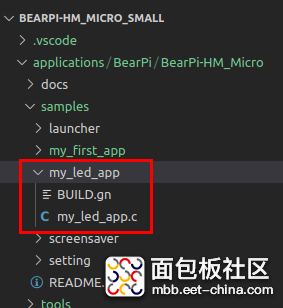
2.2.编写业务代码
在my_led_app.c中添加以下业务代码
#include <fcntl.h>#include <sys/stat.h> #include <sys/ioctl.h> #include <unistd.h> #include <stdio.h> #include "hdf_sbuf.h" #include "hdf_io_service_if.h" #define LED_WRITE_READ 1 #define LED_SERVICE "hdf_led" static int SendEvent(struct HdfIoService *serv, uint8_t eventData) { int ret = 0; struct HdfSBuf *data = HdfSBufObtainDefaultSize(); if (data == NULL) { printf("fail to obtain sbuf data!\r\n"); return 1; } struct HdfSBuf *reply = HdfSBufObtainDefaultSize(); if (reply == NULL) { printf("fail to obtain sbuf reply!\r\n"); ret = HDF_DEV_ERR_NO_MEMORY; goto out; } /* 写入数据 */ if (!HdfSbufWriteUint8(data, eventData)) { printf("fail to write sbuf!\r\n"); ret = HDF_FAILURE; goto out; } /* 通过Dispatch发送到驱动 */ ret = serv->dispatcher->Dispatch(&serv->object, LED_WRITE_READ, data, reply); if (ret != HDF_SUCCESS) { printf("fail to send service call!\r\n"); goto out; } int replyData = 0; /* 读取驱动的回复数据 */ if (!HdfSbufReadInt32(reply, &replyData)) { printf("fail to get service call reply!\r\n"); ret = HDF_ERR_INVALID_OBJECT; goto out; } printf("\r\nGet reply is: %d\r\n", replyData); out: HdfSBufRecycle(data); HdfSBufRecycle(reply); return ret; } int main(int argc, char **argv) { int i; /* 获取服务 */ struct HdfIoService *serv = HdfIoServiceBind(LED_SERVICE); if (serv == NULL) { printf("fail to get service %s!\r\n", LED_SERVICE); return HDF_FAILURE; } for (i=0; i < argc; i++) { printf("\r\nArgument %d is %s.\r\n", i, argv[i]); } SendEvent(serv, atoi(argv[1])); HdfIoServiceRecycle(serv); printf("exit"); return HDF_SUCCESS; }
复制代码2.3.编写将构建业务代码的BUILD.gn文件
BUILD.gn文件由三部分内容(目标、源文件、头文件路径)构成,需由开发者完成填写。以my_led_app为例,需要创建./applications/BearPi/BearPi-HM_Micro/samples/my_led_app/BUILD.gn,并完如下配置
import("//build/lite/config/component/lite_component.gni")HDF_FRAMEWORKS = "//drivers/framework" executable("led_lib") { output_name = "my_led" sources = [ "my_led_app.c", ] include_dirs = [ "$HDF_FRAMEWORKS/ability/sbuf/include", "$HDF_FRAMEWORKS/core/shared/include", "$HDF_FRAMEWORKS/core/host/include", "$HDF_FRAMEWORKS/core/master/include", "$HDF_FRAMEWORKS/include/core", "$HDF_FRAMEWORKS/include/utils", "$HDF_FRAMEWORKS/utils/include", "$HDF_FRAMEWORKS/include/osal", "//drivers/adapter/uhdf/posix/include", "//third_party/bounds_checking_function/include", "//base/hiviewdfx/hilog_lite/interfaces/native/innerkits", ] deps = [ "//base/hiviewdfx/hilog_lite/frameworks/featured:hilog_shared", "//drivers/adapter/uhdf/manager:hdf_core", "//drivers/adapter/uhdf/posix:hdf_posix_osal", ] } lite_component("my_led_app") { features = [ ":led_lib", ] }
复制代码- 首先导入 gni 组件,将源码my_led_app.c编译成led_lib库文件
- 输出的可执行文件名称由 output_name 定义为my_led
- include_dirs 里面加入my_led_app.c里面需要用到的.h的头文件路径
- deps 里面加入所依赖的库。
- 然后将led_lib打包成 lite_component,命名为my_led_app组件。
2.4.添加新组件
修改文件build/lite/components/applications.json,添加组件my_sample的配置
{ "component": "my_sample", "description": "my samples", "optional": "true", "dirs": [ "applications/BearPi/BearPi-HM_Micro/samples/my_first_app", "applications/BearPi/BearPi-HM_Micro/samples/my_led_app" ], "targets": [ "//applications/BearPi/BearPi-HM_Micro/samples/my_first_app:my_app", "//applications/BearPi/BearPi-HM_Micro/samples/my_led_app:my_led_app" ], "rom": "", "ram": "", "output": [], "adapted_kernel": [ "liteos_a" ], "features": [], "deps": { "components": [], "third_party": [ ] } },
复制代码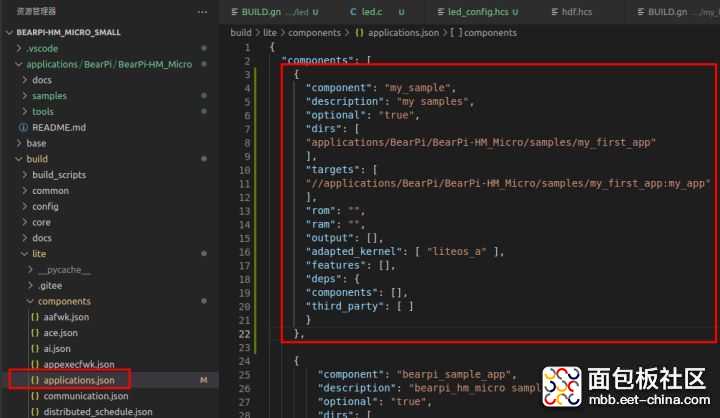
2.5.修改单板配置文件
修改文件vendor/bearpi/bearpi_hm_micro/config.json,新增my_sample组件的条目
{ "subsystem": "applications", "components": [ { "component": "my_sample", "features":[] }, { "component": "bearpi_sample_app", "features":[] }, { "component": "bearpi_screensaver_app", "features":[] } ] },
复制代码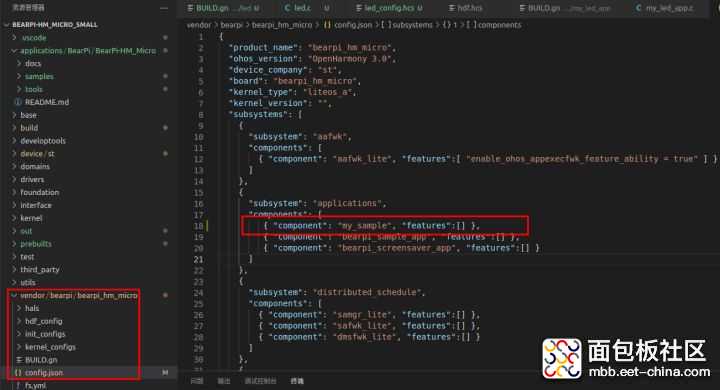
三、编译
在项目根目录下执行hb set 设置开发板,只有一个,回车即可

执行编译命令
hb build -t notest --tee -f 等待编译完成后,屏幕出现:build success字样,说明编译成功。
当编译完后,可以直接查看到最终编译的固件,具体路径在: \project\bearpi-hm_micro_small\out\bearpi-hm_micro\bearpi-hm_micro
文件夹结构说明
- OHOS_Image.stm32:系统镜像文件
- rootfs_vfat.img:根文件系统
- userfs_vfat.img:用户文件系统
执行以下三条指令将以上三个文件复制到applications/BearPi/BearPi-HM_Micro/tools/download_img/kernel/下,以便后续烧录系统使用
cp out/bearpi_hm_micro/bearpi_hm_micro/OHOS_Image.stm32 applications/BearPi/BearPi-HM_Micro/tools/download_img/kernel/cp out/bearpi_hm_micro/bearpi_hm_micro/rootfs_vfat.img applications/BearPi/BearPi-HM_Micro/tools/download_img/kernel/ cp out/bearpi_hm_micro/bearpi_hm_micro/userfs_vfat.img applications/BearPi/BearPi-HM_Micro/tools/download_img/kernel/
复制代码四、总结
至此,完整的项目工程就开发好了,下一步就是烧录和运行了。






 /5
/5 


